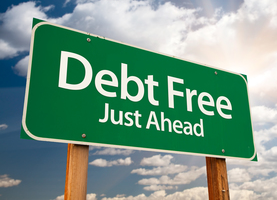by Susan Paige

Did you know that the average American has over $30,000 in personal debt not including a mortgage?
It’s no wonder that people are desperately trying to figure out how to get out of debt.
I compared repayment strategies and put together the list below of the best ways for paying off debt. Keep reading to learn what they are, how they work, and if they’re right for you.
6 Best Repayment Strategies for Paying off Debt Once and for All
When debt gets out of control it can affect a person emotionally and physically because it can become overwhelming. Paying off debt is not impossible with the right attitude and approach. Taking it one step at a time will make the process a bit easier and allow you to even start an emergency fund if you don’t have one yet.
1. Snowball Method
If you haven’t heard of the snowball method it’s not very complicated and can be used to pay off all the debt that you have. With this method, you’ll be paying off your debt starting from the smallest balance to the largest. You can get motivated right from the start because you will be able to see small debts paid off early on.
After you make your list from smallest to the largest debt you put as much extra money as you can each month to pay off the smallest balance on your list. Once that first smaller balance is paid off you will take the money you were paying towards it and use it towards the second debt on the list. This payment is in addition to that second debts minimum monthly payment.
Every time you zero out a debt on your list you will have more money to pay off the following debt. Choosing this method is great to use when you have a long list of debts. It’s also a great method to choose if you need the motivation to pay off a ton of debt.
One of the downsides of using this method is that you’re not taking into account the interest rates associated with each account instead you’re looking at the amount of the debt to pay of the smallest first. When you don’t pay off debt based on who has the higher interest rates you might end up paying more interest in the long run.
On a side note and pretty big key as you pay off credit cards don’t fall into the trap of using them unless it’s a major emergency. The point of paying them off is to not max them out with a house renovation, or a shopping spree.
2. 401k Loan
If you have a 401k retirement plan then you might want to use this to pay off your debt so that you don’t have to worry about owing different monthly bills just one. The interest you pay back on a 401k loan is usually a little less than credit card interest rates.
When you take out a 401k loan and begin to repay it the repayment is going back to you. This is a huge deal because it means that the interest you’re required to pay back goes back into your 401k account. Yes, that’s correct you get all that interest, not the lender.
Although this option is great if you have a 401k you want to keep in mind that you have to repay the loan within five years of taking it out and if you leave your job before it’s paid off it will be due immediately. If for some reason you can’t repay it after leaving your job it will be treated as income and you’ll have to pay taxes on the amount plus a penalty tax for early withdrawal.
If you choose this method think twice about leaving your job before your 401k loan is repaid.
3. Negotiate
If you feel that the money isn’t there and you don’t have the option of a 401k loan, family loan, personal loan or any other method you can call up each account and talk to them. Tell them your situation and that you want to repay them but need to negotiate your terms.
You can ask for lower payments, lower interest rates, or a new repayment schedule. Make sure that you let them know that if you can’t come to an agreement you will have no choice but to file for bankruptcy because of your situation. Most creditors would rather get paid some of their money back instead of having a total loss.
Everything in the debt world is negotiable if you’re willing to take time to call and ask. Don’t get scared to stand up for yourself as long as you’re being honest. You never know until you ask.
You might be surprised at how low they’re willing to go because they really don’t want to go through the process of hiring a debt collector and make $0 in the end if you end up never paying it or filing for bankruptcy.
4. Balance Transfers
This method works if you have a credit card with some available credit. You can transfer debt from one card to another. Make sure you only do this if the interest rate is less on the new card. Basically what you’re doing is paying one credit card off with another but paying less in interest as long as the new card is a lower rate.
There are some credit cards available that offer a 0% interest rate for an introductory period which will automatically set you up to save a ton on those pesky interest rates. You can compare and choose a card that offers the longest promotional period to pay with zero interest.
Take the amount you transferred and divide it into the number of months for the promo period and make it a point to pay it off before the promo period is over. If you end up going past the promo period most cards will charge you the interest that accumulated from day 1. This can mean two things:
- Paying extra in interest
- Larger monthly payments
This detailed comparison will give you a few credit card options that might work if you have a decent credit score and will approve you for a new line of credit. You can also set up automated sweep transfers to move funds over a given amount from one account to another on a recurring basis.
5. Avalanche Method
This is another great method you can use to pay off your debt. The first thing you’ll do with this method is to make a list of all of your debts and put them in order from highest interest rate to the lowest interest rate. You will continue to make minimum payments on all of your accounts and choose how much extra you will pay monthly towards the account with the highest interest.
Once the higher interest debt is paid off you can move on to the next largest interest debt on your list and use the money you were using from the previous account to pay the next debt quicker. It’s similar to the snowball method except that you’re going in an order based on the highest interest first.
In the long run, you will pay less money because you’re tackling high debt first. In the beginning, it might seem like nothing is happening but once you pay off that first higher interest debt it will suddenly gain quick momentum. Choosing this method will also mean you will get out of debt quicker.
The same key applies here as mentioned above for the snowball method – don’t max out the credit cards after paying them off. There is no point in going through all this trouble to immediately run up the cards and find yourself drowning in debt again. This will completely defeat the purpose and leave you feeling exhausted.
6. Home Equity Loan
If you own your home and it currently has equity accumulated you might want to use it to pay off all of your debt. This will leave you with only owing money towards your home equity.
One of the pros of taking a home equity loan is that you pay less in interest. Another pro is that sometimes it can be used as a deductible item if you itemize deductions on your income taxes.
The key with taking out a home equity loan is to not use your cards again after paying them off with this loan. That will defeat the purpose. You will end up owing the home equity loan and the credit cards if you fall into this trap.
Breathe
Now that you have read the list of options above you can breathe. Take a minute to soak it all in and choose which method you feel would work best for you. There is no right or wrong way as long as you get one foot in front of the other to get started on your journey to paying off debt.
If you’re looking at some finance tips and ideas check out our personal finance section where you can find a wealth of information on your own debt free journey.


So, what do you think ?